Low-Cost Transmitarray Design with High Gain Bandwidth and Suppressed SLL
Abstract
1. Introduction
2. Unit Cell Design
3. Design and Measurement of the Proposed Transmitarray with High Gain Bandwidth and Suppressed SLL
4. Conclusions
Author Contributions
Funding
Data Availability Statement
Acknowledgments
Conflicts of Interest
Abbreviations
| SLL | Side Lobe Level |
| PRS | Partially Reflecting Surface |
| LP | Linear Polarization |
| CP | Circular Polarization |
| EMMPTE | Extended Method of Maximum Power Transmission Efficiency |
| WCMMPTE | Weighted Constrained Method of the Maximum Power Transmission Efficiency |
| PSO | Particle Swarm Optimization |
References
- Yin, T.; Ren, J.; Cai, Y.-M.; Liu, Y.-T.; Zhang, B.; Deng, Y.; Liu, Y.; Yin, Y. Wideband High-Efficiency Transmitarray Antenna Using Compact Double-Layer Dual-Linearly Polarized Elements. IEEE Antennas Wirel. Propag. Lett. 2023, 22, 2372–2376. [Google Scholar] [CrossRef]
- Song, C.; Pan, L.; Jiao, Y.; Jia, J. A High-Performance Transmitarray Antenna with Thin Metasurface for 5G Communication Based on PSO (Particle Swarm Optimization). Sensors 2020, 20, 4460. [Google Scholar] [CrossRef]
- Malkoç, M.; Ünaldı, S.; Çimen, S. Low Profile mm-Wave Transmitarray Design for 5G Applications. In Proceedings of the 5th International Congress on Contemporary Scientific Research (ICCSR), Kayseri, Turkey, 21–22 April 2024. [Google Scholar]
- Dai, X.; Wu, G.-B.; Luk, K.-M. A Wideband Circularly Polarized Transmitarray Antenna for Millimeter-Wave Applications. IEEE Trans. Antennas Propag. 2023, 71, 1889–1894. [Google Scholar] [CrossRef]
- Hu, H.-T.; Chan, K.F.; Chan, C.H. Low-Profile Circular-Polarized Filtering Transmitarray Antenna in V-Band. IEEE Trans. Antennas Propag. 2024, 72, 938–943. [Google Scholar] [CrossRef]
- de Kok, M.; Vertegaal, C.J.C.; Smolders, A.B.; Johannsen, U. A 34- to 36-GHz Active Transmitarray for Ka-Band Tracking Radar Using 5G Tx/Rx Beamforming ICs: Design and 64-Element Demonstrator. IEEE Trans. Antennas Propag. 2023, 71, 3260–3272. [Google Scholar] [CrossRef]
- Yi, X.-J.; Su, T.; Wu, B.; Chen, J.-Z.; Yang, L.; Li, X. A Double-Layer Highly Efficient and Wideband Transmitarray Antenna. IEEE Access 2019, 7, 23285–23290. [Google Scholar] [CrossRef]
- Belen, M.A.; Caliskan, A.; Koziel, S.; Pietrenko-Dabrowska, A.; Mahouti, P. Optimal Design of Transmitarray Antennas via Low-Cost Surrogate Modelling. Sci. Rep. 2023, 13, 15044. [Google Scholar] [CrossRef] [PubMed]
- Lei, H.; Jia, Y.; Chen Zhong, Y.; Liu, Z.; Shi, G.; Liu, Y. A Low-Profile Metal-Only Folded Transmitarray Antenna Based on Asymmetric Transmission Chiral Metasurface. IEEE Trans. Antennas Propag. 2024, 72, 9480–9485. [Google Scholar] [CrossRef]
- Li, M.-Y.; Ban, Y.-L.; Yan, F.-Q. Wideband Low-Profile Ku-Band Transmitarray Antenna. IEEE Access 2021, 9, 6683–6688. [Google Scholar] [CrossRef]
- Wu, F.; Wang, J.; Xiang, L.; Hong, W.; Luk, K.-M. A Wideband Dual-Polarized Magneto-Electric Dipole Transmitarray with Independent Control of Polarizations. IEEE Trans. Antennas Propag. 2022, 70, 8632–8636. [Google Scholar] [CrossRef]
- Nguyen, B.D.; Nguyen, M.T.; Van, V. An Efficient Approach for Designing Ultrathin Transmitarray Antennas Based on Equivalent Circuit Analysis. IEEE Trans. Antennas Propag. 2024, 72, 5810–5821. [Google Scholar] [CrossRef]
- Song, L.-Z.; Qin, P.-Y.; Guo, Y.J. A High-Efficiency Conformal Transmitarray Antenna Employing Dual-Layer Ultrathin Huygens Element. IEEE Trans. Antennas Propag. 2021, 69, 848–858. [Google Scholar] [CrossRef]
- Derafshi, I.; Komjani, N. A New High Aperture Efficiency Transmitarray Antenna Based on Huygens Metasurfaces. IEEE Trans. Antennas Propag. 2022, 70, 5458–5467. [Google Scholar] [CrossRef]
- Wang, X.; Qin, P.-Y.; Song, L.-Z.; Jin, R.; Guo, Y.J. Tightly Coupled Huygens Element-Based Conformal Transmitarray for E-Band Airborne Communication Systems. IEEE Trans. Antennas Propag. 2023, 71, 2467–2475. [Google Scholar] [CrossRef]
- Li, T.-J.; Wang, G.-M.; Li, H.-P.; Hou, H.-S. Circularly Polarized Double-Folded Transmitarray Antenna Based on Receiver-Transmitter Metasurface. IEEE Trans. Antennas Propag. 2022, 70, 11161–11166. [Google Scholar] [CrossRef]
- Wang, Y.; Xu, S.; Yang, F.; Werner, D.H. 1 Bit Dual-Linear Polarized Reconfigurable Transmitarray Antenna Using Asymmetric Dipole Elements with Parasitic Bypass Dipoles. IEEE Trans. Antennas Propag. 2021, 69, 1188–1192. [Google Scholar] [CrossRef]
- Moon, B.; Oh, J. FSS-Enhanced Quasi-Optical Dielectric Measurement Method for Liquid Crystals in Sub-THz Band. IEEE Antennas Wirel. Propag. Lett. 2023, 22, 3062–3066. [Google Scholar] [CrossRef]
- Zhang, Z.; Li, X.; Sun, C.; Liu, Y.; Han, G. Dual-Band Focused Transmitarray Antenna for Microwave Measurements. IEEE Access 2020, 8, 100337–100345. [Google Scholar] [CrossRef]
- Li, W.; Wang, Y.; Sun, S.; Shi, X. An FSS-Backed Reflection/Transmission Reconfigurable Array Antenna. IEEE Access 2020, 8, 23904–23911. [Google Scholar] [CrossRef]
- Luo, Q.; Gao, S.; Sobhy, M.; Yang, X. Wideband Transmitarray with Reduced Profile. IEEE Antennas Wirel. Propag. Lett. 2018, 17, 450–453. [Google Scholar] [CrossRef]
- Wu, R.Y.; Li, Y.B.; Wu, W.; Shi, C.B.; Cui, T.J. High-Gain Dual-Band Transmitarray. IEEE Trans. Antennas Propag. 2017, 65, 3481–3488. [Google Scholar] [CrossRef]
- Reis, J.R.; Caldeirinha, R.F.S.; Hammoudeh, A.; Copner, N. Electronically Reconfigurable FSS-Inspired Transmitarray for 2-D Beamsteering. IEEE Trans. Antennas Propag. 2017, 65, 4880–4885. [Google Scholar] [CrossRef]
- Sun, S.; Wang, M.; Wen Cheng, Z.; Jun Cui, T.; Ma, H.F. A Dual-Band Circularly-Polarized Transmitarray Antenna with Simultaneous Low Side-Lobe and Cross-Polarization Level. IEEE Open J. Antennas Propag. 2024, 5, 1758–1764. [Google Scholar] [CrossRef]
- Dong, Y.; Cai, X.; Wen, G. Circularly Polarized Antenna Array with Suppressed Sidelobes for Electronic Toll Collection. IEEE Antennas Wirel. Propag. Lett. 2022, 21, 988–992. [Google Scholar] [CrossRef]
- Dong, Y.; Cai, X.; Geyi, W. A Weighted Method for Multibeam Synthesis with Controllable Gain and Sidelobe Suppression. IEEE Trans. Antennas Propag. 2025, 73, 5291–5299. [Google Scholar] [CrossRef]
- Cai, X.; Zhao, Q.; Xu, P.; Geyi, W. Synthesis of Cosecant-Squared Pattern with a Compact Linear Array Using the Extended Method of Maximum Power Transmission Efficiency. IEEE Antennas Wirel. Propag. Lett. 2025, 24, 863–867. [Google Scholar] [CrossRef]
- Xiang, B.-J.; Luk, K.-M. A Wideband Dual-Linearly Polarized Folded ME-Dipole Transmitarray Antenna with Low H/F Ratio. IEEE Trans. Antennas Propag. 2024, 72, 466–475. [Google Scholar] [CrossRef]
- Chatterjee, S.; Gupta, Y.; Maulik, A.; Bhattacharyya, S. An Optimized Phase-Controlled Metasurface-Based Low-Profile Folded Transmitarray (FTA) Antenna. IEEE Trans. Antennas Propag. 2025, 73, 3316–3321. [Google Scholar] [CrossRef]
- Lee, J.-G.; Lee, J.-H. Low-Profile High-Efficiency Transmitarray Antenna for Beamforming Applications. Electronics 2023, 12, 3178. [Google Scholar] [CrossRef]
- Reis, J.R.; Vala, M.; Caldeirinha, R.F.S. Review Paper on Transmitarray Antennas. IEEE Access 2019, 7, 94171–94188. [Google Scholar] [CrossRef]
- Jia, Q.-S.; Zhang, W.-H.; Han, X.; Huang, Y.-M.; Ding, S.; Wang, B.-Z.; Bozzi, M. A Broadband Filtering Circularly Polarized Folded Transmitarray Antenna Based on Metasurface. IEEE Antennas Wirel. Propag. Lett. 2023, 22, 2357–2361. [Google Scholar] [CrossRef]
- Tian, C.; Zhao, G.; Du, R.-N.; Zhang, Z.; Wang, Y.-W. A High Efficiency Transmitarray Using Two-Layer Elements Etched on Compound Substrate. IEEE Access 2022, 10, 40073–40078. [Google Scholar] [CrossRef]
- Song, L.; Wang, Y.; Guo, L. A Low-Cost Ultrathin Metal-Only Transmitarray Antenna at X-Band. Antennas Wirel. Propag. Lett. 2024, 23, 1443–1447. [Google Scholar] [CrossRef]
- Gao, S.; Wong, H. Design of a Dual-Band Shared-Aperture Antenna Combining Fabry–Perot Cavity and Folded Transmitarray for X- and Ka-Bands. IEEE Trans. Antennas Propag. 2024, 72, 323–331. [Google Scholar] [CrossRef]
- Dicandia, F.A.; Genovesi, S. Low Profile Dual Linearly Polarized 1-Bit Transmitarray Exploiting Two Metallic Layers. IEEE Access 2024, 12, 56872–56879. [Google Scholar] [CrossRef]
- Tian, C.; Lu, Y.-Q.; Zhao, G.; Jiao, Y.-C.; Guo, L.-X. Double-Layer Transmitarray Antenna Using Specially Designed Substrate. IEEE Antennas Wirel. Propag. Lett. 2022, 21, 441–445. [Google Scholar] [CrossRef]
- Malkoç, M. X ve Ka Bant Uygulamaları için Yüksek Kazanç Bant Genişliğine Sahip İleti Dizi Anten Tasarımları. Master’s Thesis, Bilecik Şeyh Edebali University, Bilecik, Turkey, 2024. [Google Scholar]
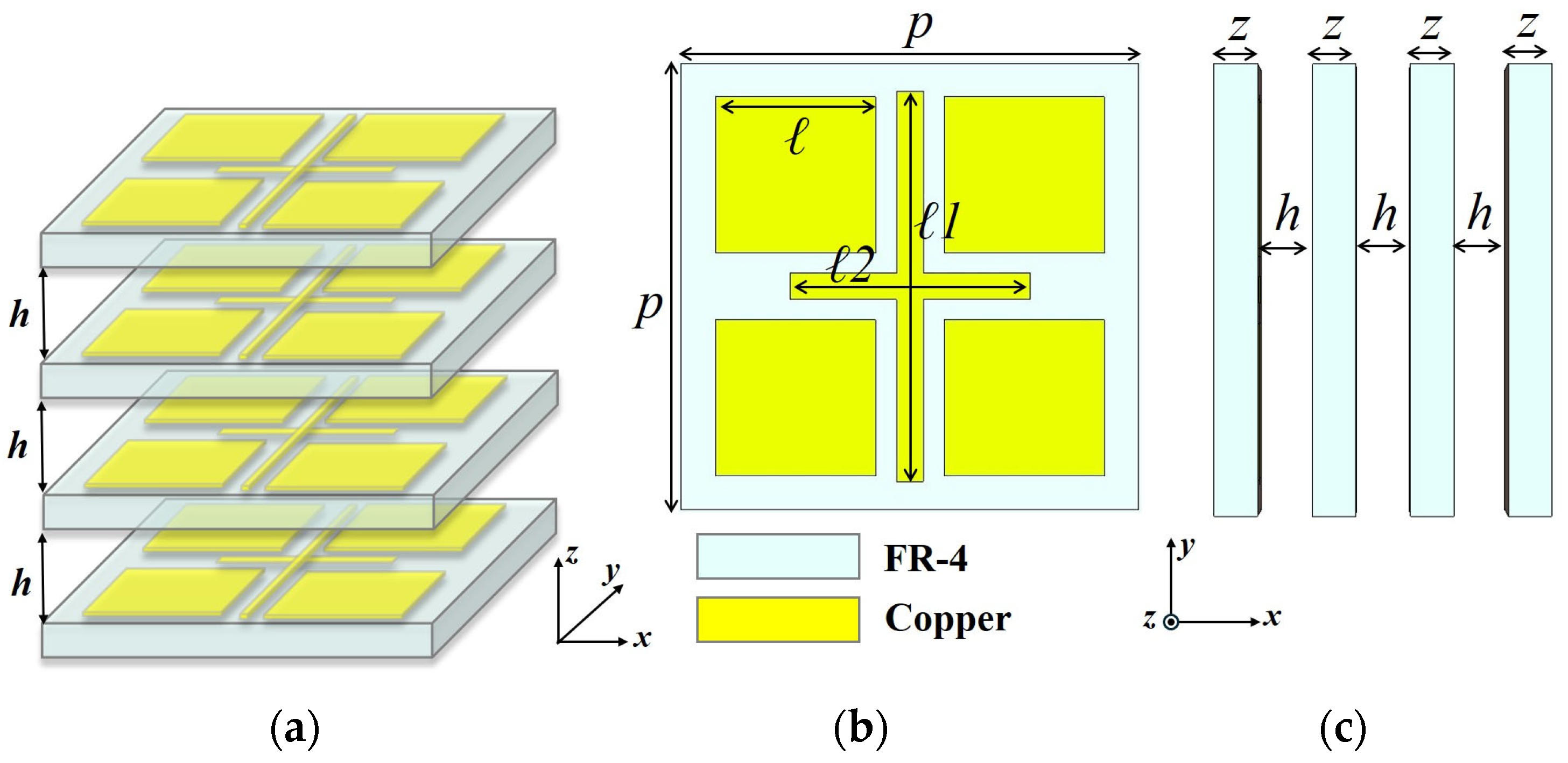
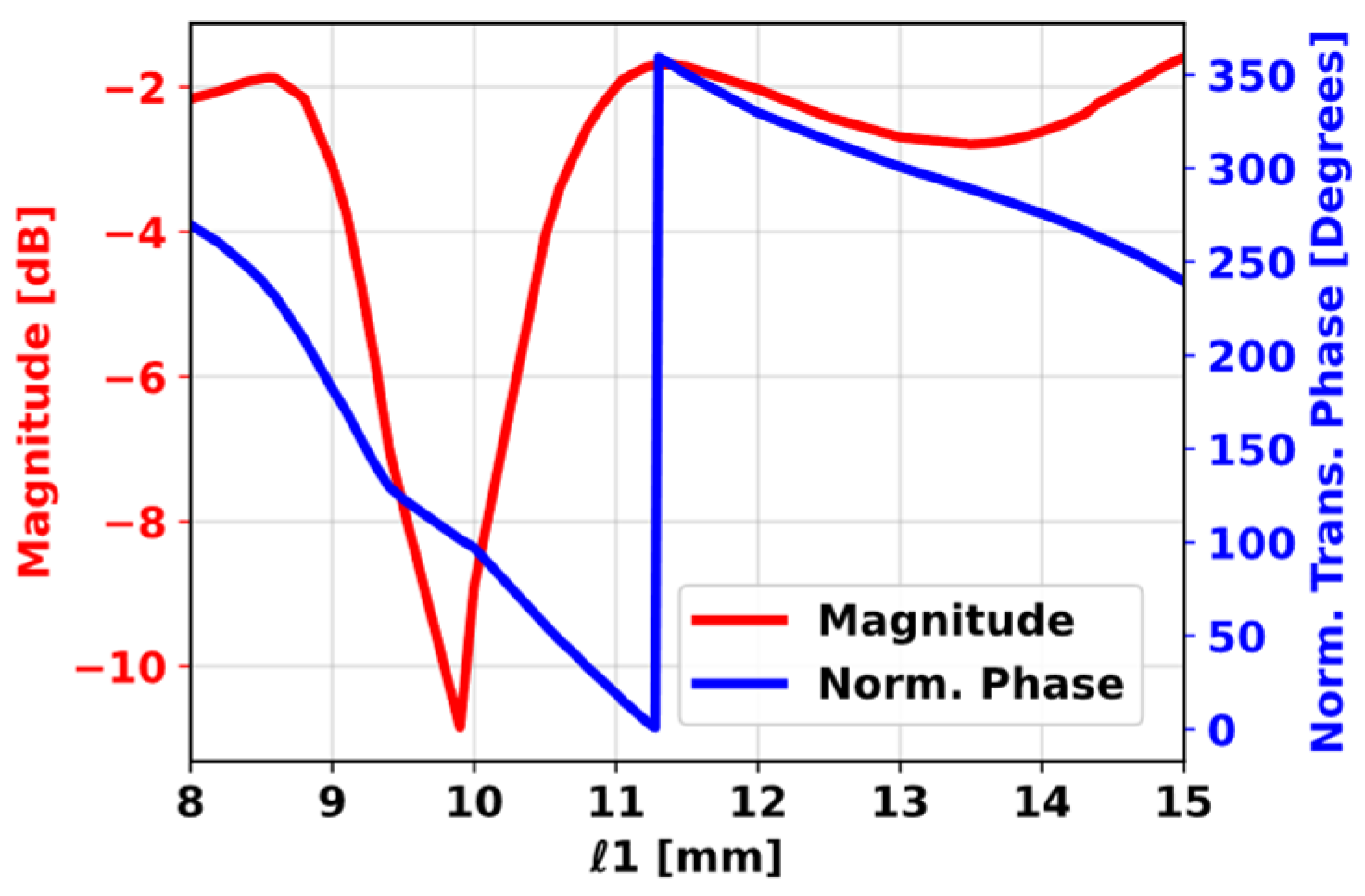
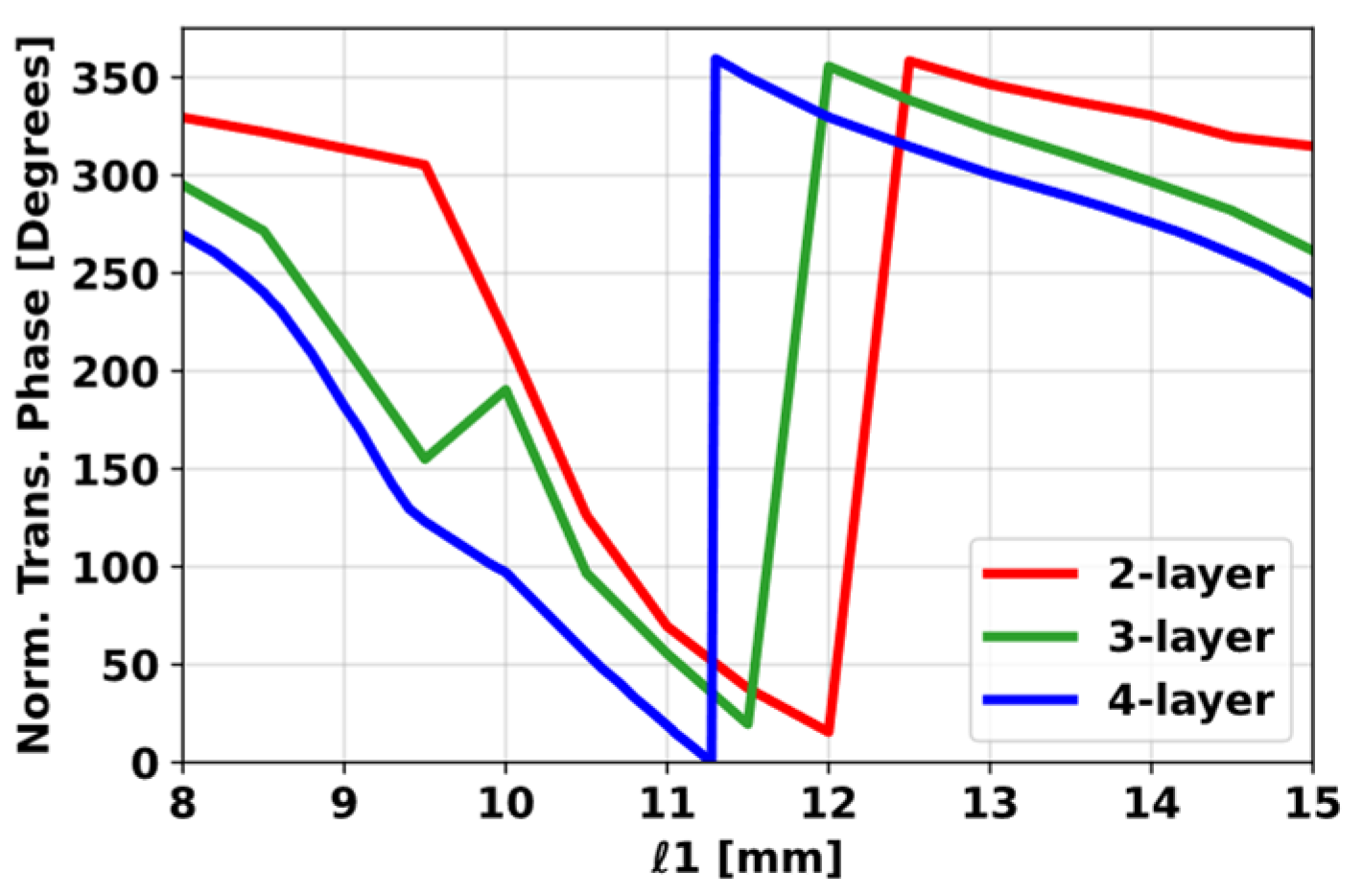
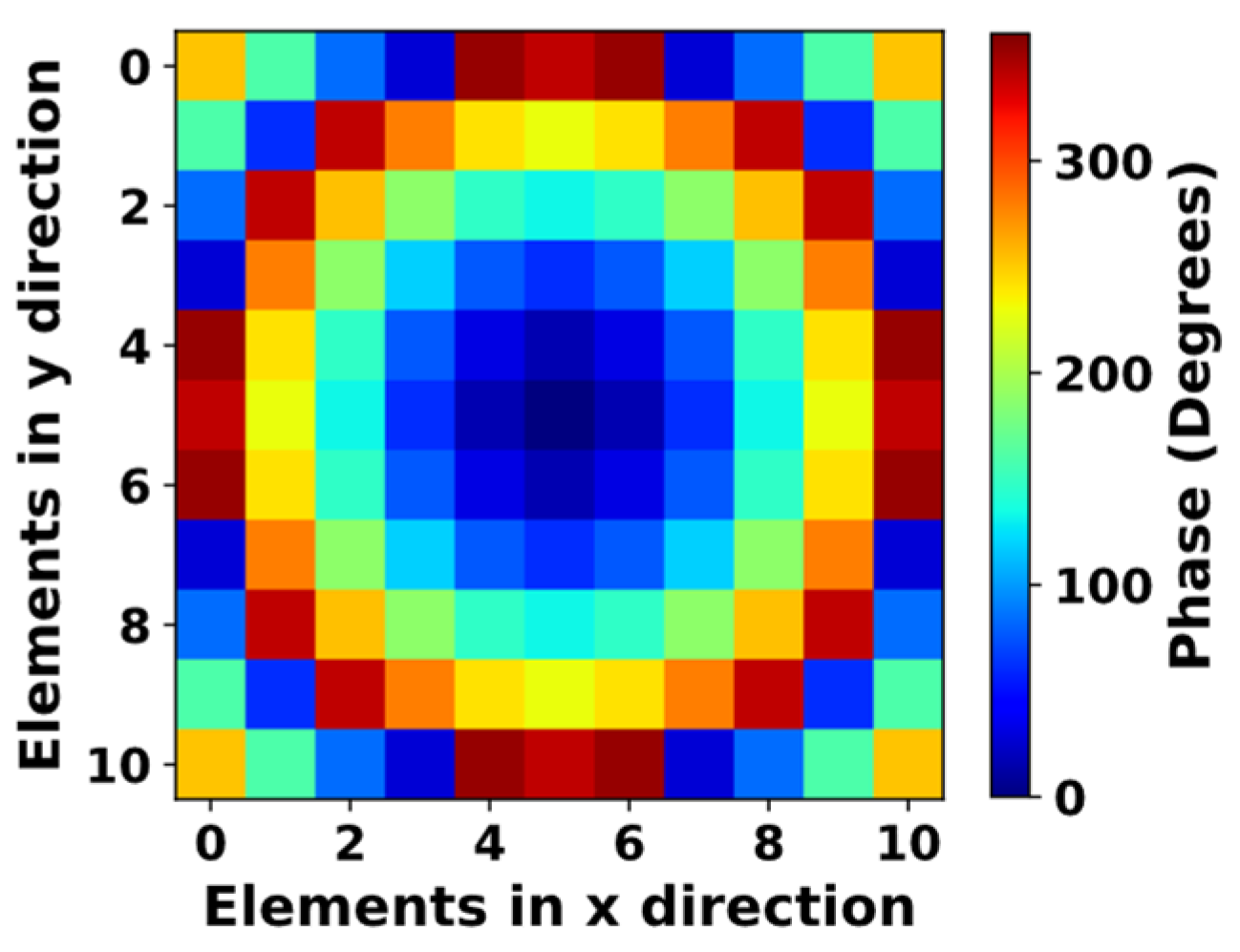
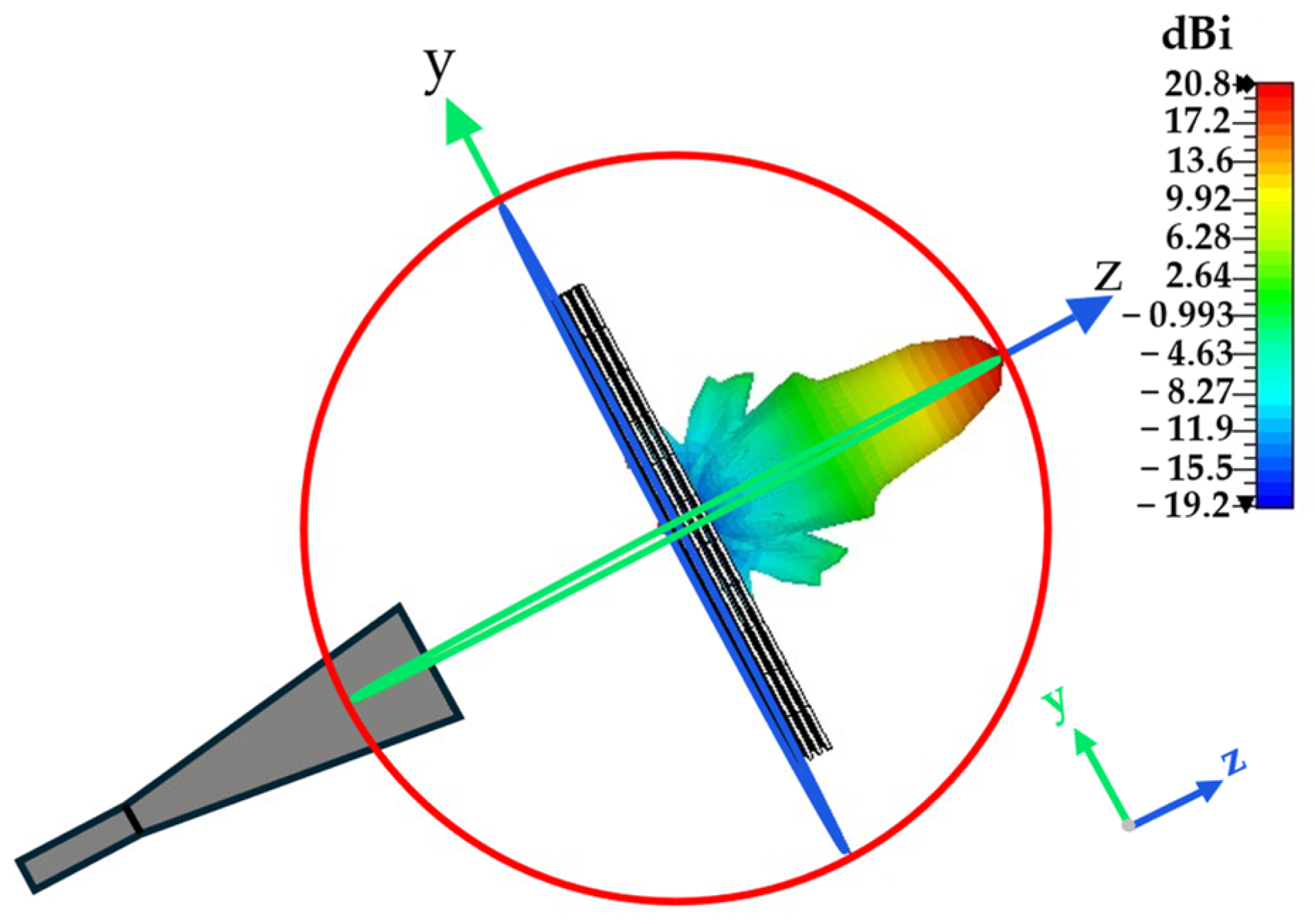
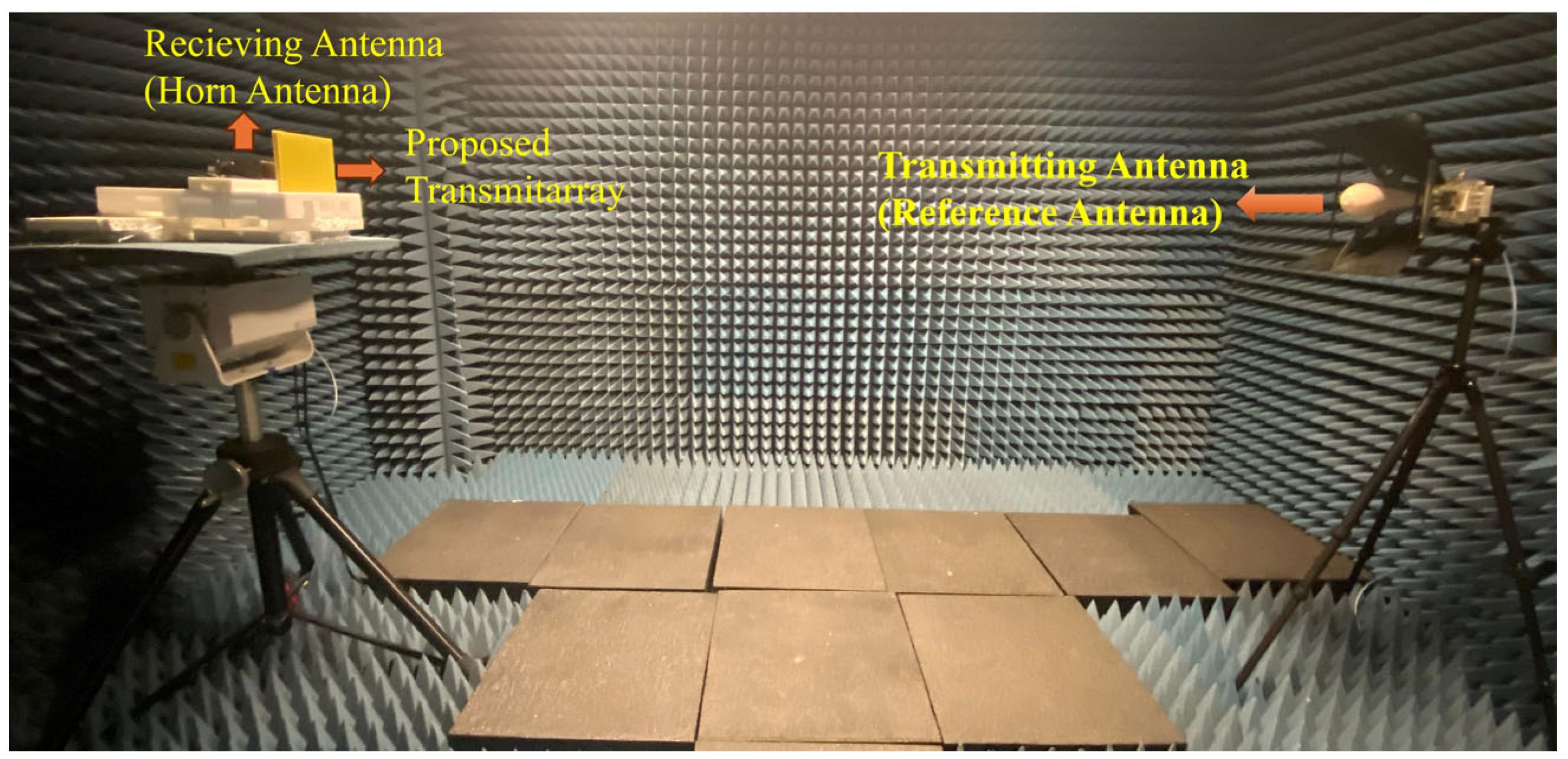
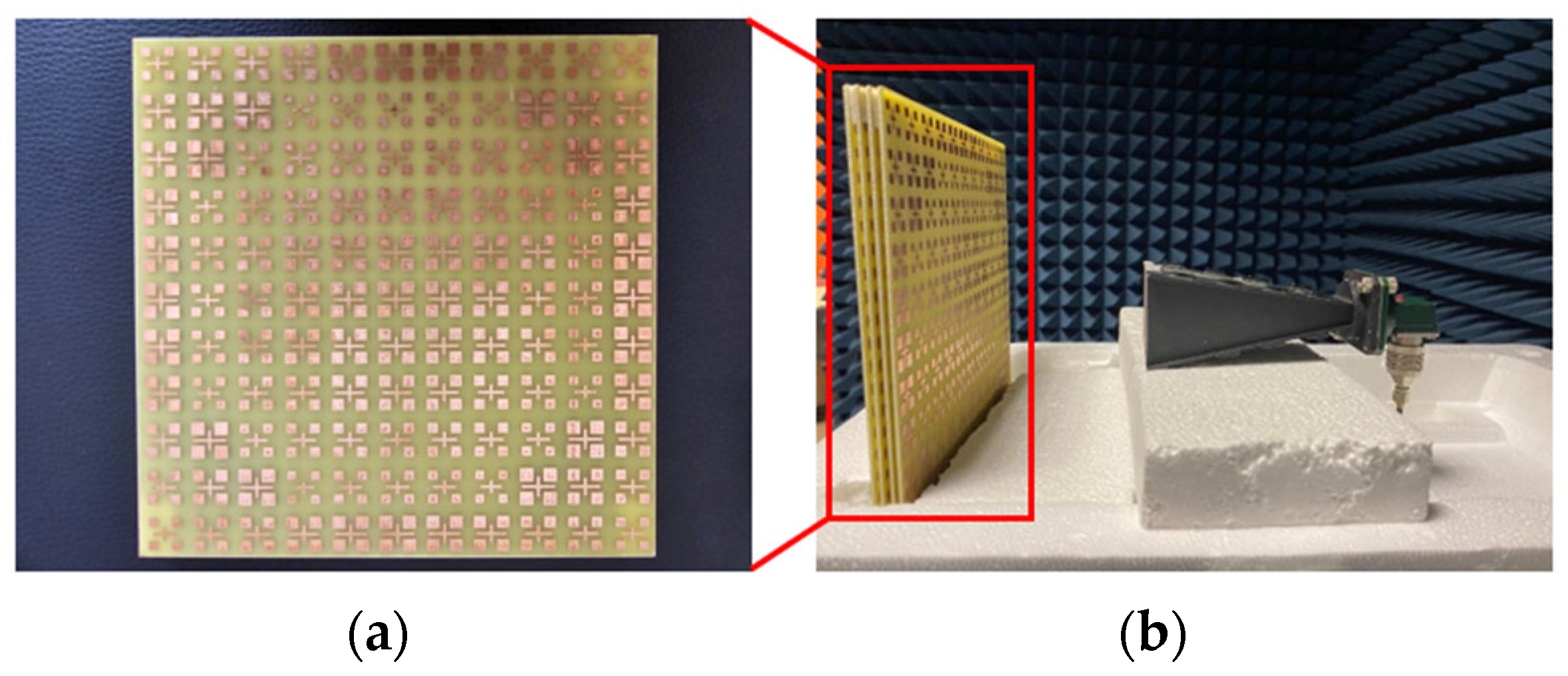
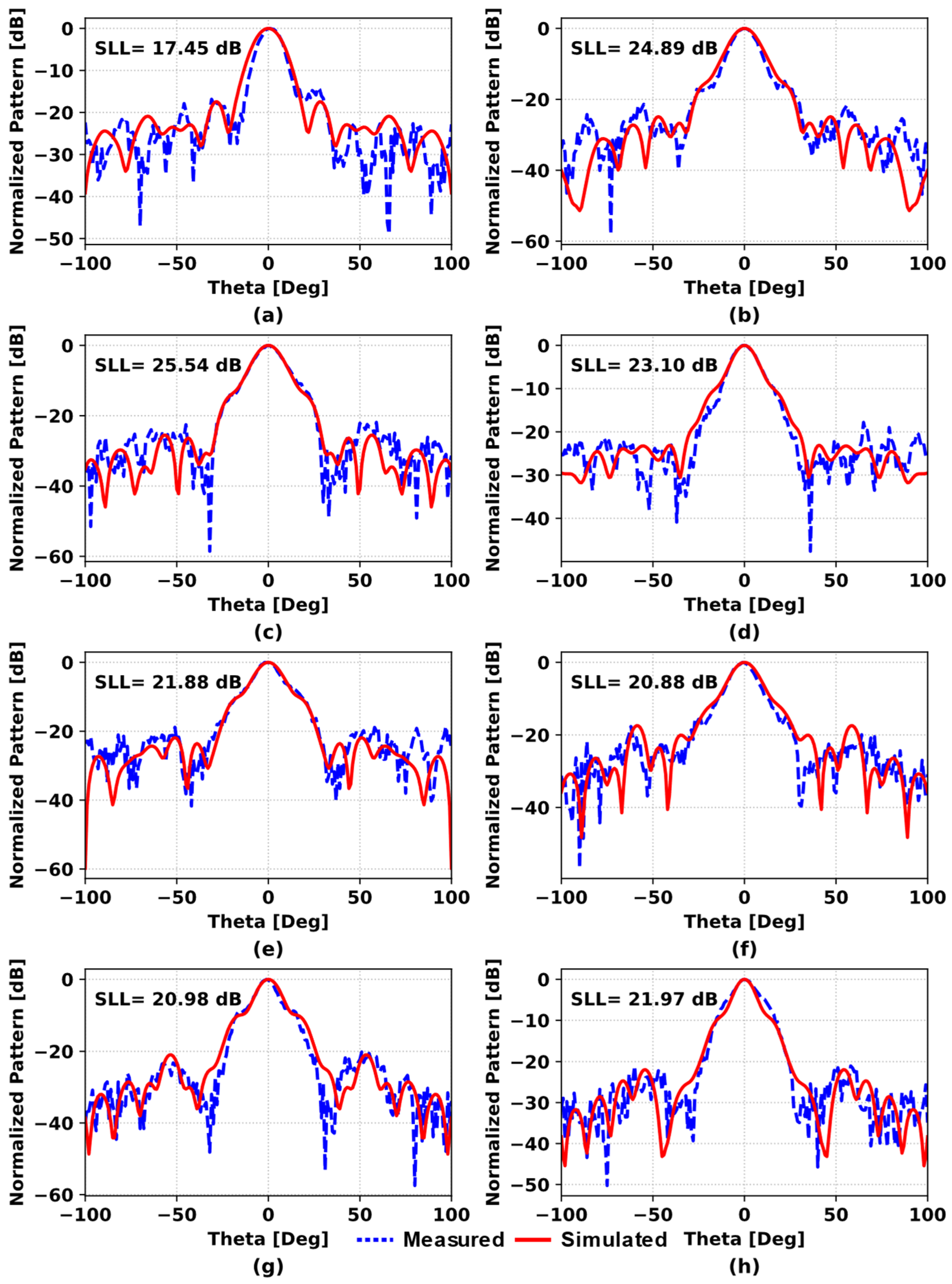
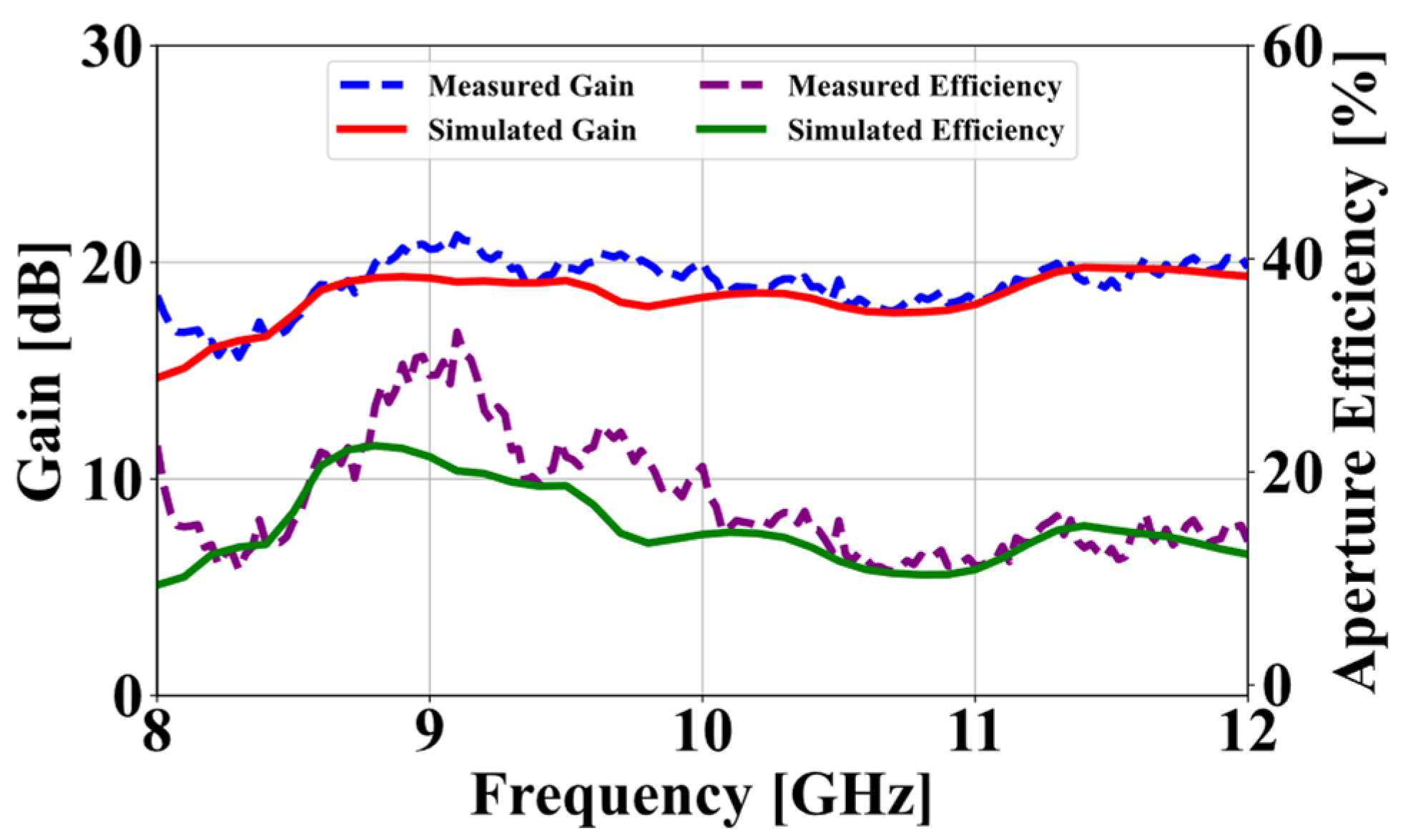
| Ref. | Freq. (GHz) | Number of Metallic Layers | F/D | Unit Cell Dimension (λ0) | Aperture Size (λ0) | Phase Range (°) | Via | 1-dB/3-dB Gain BW (%) | Aperture Efficiency (%) | SLL (dB) |
|---|---|---|---|---|---|---|---|---|---|---|
| [28] | 26 | 2 | 0.4 | 0.56 | 9.02 | 1-Bit | Yes | 12 (1-dB) 26 (3-dB) | 20 | Not Specific |
| [32] | 10 | 3 | 0.25 | 0.47 | 10.7 | 360 | No | 24.5 (3-dB) | 40 | <25 |
| [33] | 10 | 2 | 1.27 | 0.32 | 6.08 | 360 | No | 7.5 (1-dB) | 58.5 | Not Specific |
| [34] | 10 | 2 | 0.64 | 0.067 | 9.5 | 360 | No | 7 (1-dB) | 42 | 20.5 |
| [35] | 9 | 3 | 0.56 | 0.54 | 12.96 | 2-Bit | No | 8.1 (1-dB) | 45 | <15 |
| [36] | 8 | 2 | 1.5 | 0.21 | Not Specific | 1-Bit | Yes | 16.5 (3-dB) | 30.4 | <15.3 |
| [37] | 12 | 2 | 1.4 | 0.52 | 5.72 | 360 | No | 5.4 (1-dB) | 44 | 13.4 |
| This Work | 9 | 4 | 0.53 | 0.51 | 5.61 | 360 | No | 12.12 (1-dB) 49.43 (3-dB) | 21.3 | 24.89 |
Disclaimer/Publisher’s Note: The statements, opinions and data contained in all publications are solely those of the individual author(s) and contributor(s) and not of MDPI and/or the editor(s). MDPI and/or the editor(s) disclaim responsibility for any injury to people or property resulting from any ideas, methods, instructions or products referred to in the content. |
© 2025 by the authors. Licensee MDPI, Basel, Switzerland. This article is an open access article distributed under the terms and conditions of the Creative Commons Attribution (CC BY) license (https://creativecommons.org/licenses/by/4.0/).
Share and Cite
Malkoç, M.; Ünaldı, S.; Çimen, S. Low-Cost Transmitarray Design with High Gain Bandwidth and Suppressed SLL. Electronics 2025, 14, 4044. https://doi.org/10.3390/electronics14204044
Malkoç M, Ünaldı S, Çimen S. Low-Cost Transmitarray Design with High Gain Bandwidth and Suppressed SLL. Electronics. 2025; 14(20):4044. https://doi.org/10.3390/electronics14204044
Chicago/Turabian StyleMalkoç, Muhammed, Sibel Ünaldı, and Sibel Çimen. 2025. "Low-Cost Transmitarray Design with High Gain Bandwidth and Suppressed SLL" Electronics 14, no. 20: 4044. https://doi.org/10.3390/electronics14204044
APA StyleMalkoç, M., Ünaldı, S., & Çimen, S. (2025). Low-Cost Transmitarray Design with High Gain Bandwidth and Suppressed SLL. Electronics, 14(20), 4044. https://doi.org/10.3390/electronics14204044







